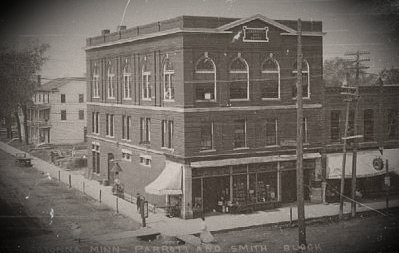Parrott & Smith Building
Parrot & Smith Building
Photo courtesy of the Minnesota Historical Society
Parrot and Smith Building, 2012
The Parrott & Smith building, located on the northwest corner of Cedar and Vine Streets, was designed by Frank Alden Gutterson in 1899. Gutterson, who was born in Owatonna, was also the architect of the original Central Park bandstand, the Owatonna Public Library, and Hastings residence, now the Northrop-Oftedahl House. Designed in a classical style, the Parrott & Smith building is one of only a few three-story buildings in the downtown area. The building housed the Parrott & Smith hardware store on the main floor, with doctor’s offices on the second floor.
On November 18, 1905, a fire of unknown origin began in the basement of the building. The fire spread rapidly, eventually leading to the collapse of interior floors and the roof. Several kegs of powder exploded in the basement, shaking the neighborhood.
The owners at first thought to rebuild the building with two floors, but eventually went on to rebuild within the original three-story brick structure. The third floor was then occupied by the Odd Fellows Lodge, which included a large open room at the front of the building.
The hardware store continued at the location until the 1950’s. The 1947-48 city directory list the following as occupants of the building: Parrott Hardware Company (main floor), Upper floors: Owatonna Chamber of Commerce; F.A. Alexander, attorney; Registrar of Motor Vehicles; Dr. J.D. Rowley; First Church of Christ Scientists; Christian Science Reading Room; International Order of Odd Fellows.
By 1961, the building housed the Nelson, Casey, Tripp & Dow law office as well as Farmers Insurance Agency, Mecham Realty, Neal K. Nelson, dentist, Fred A. Alexander, lawyer, Clara’s Tailor Shop, Julian D. Rowley, osteopath, and Commercial Printing Company.
The Parrott & Smith building is currently occupied by the law firm of Einhaus, Mattison, Carver & Haberman, p.a. Other offices are located on the second floor. The interior of the building still contains remarkable tinwork on both ceilings and walls. Over a hundred years old, the building continues to be a prominent structure in the downtown area and has recently been renovated.
Courtesy of Nancy Vaillancourt



